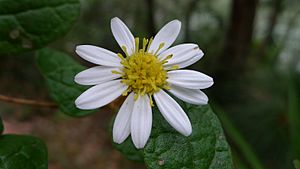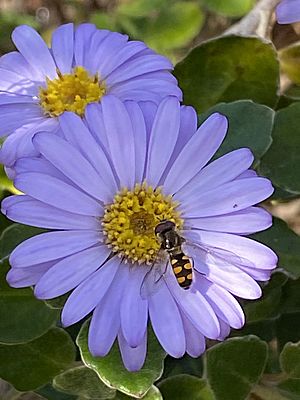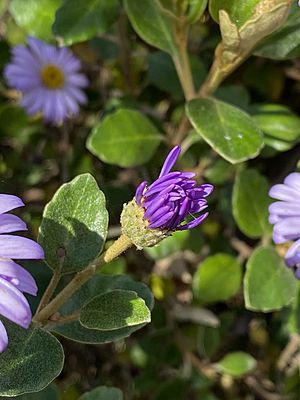Toothed daisy-bush facts for kids
Olearia tomentosa, also known as the toothed daisy bush or downy daisy bush, is a type of shrub or small shrub. It belongs to the Asteraceae family, which is the same family as daisies and sunflowers. This plant is native to Australia.
Quick facts for kids Toothed daisy-bush |
|
|---|---|
 |
|
| Scientific classification | |
| Kingdom: | |
| (unranked): | |
| (unranked): | |
| (unranked): | |
| Order: | |
| Family: | |
| Tribe: |
Astereae
|
| Genus: |
Olearia
|
| Species: |
O. tomentosa
|
| Binomial name | |
| Olearia tomentosa (J.C.Wendl.) DC.
|
|
| Synonyms | |
|
|
Contents
What is the Downy Daisy Bush?
This plant is a woody shrub that grows upright. It can reach up to 2 metres (about 6.5 feet) tall. Its stems and leaves are covered in soft, fine hairs, which is why it's called "downy."
The leaves are oval-shaped and grow alternately along the stems. They are usually between 1 and 8.5 centimetres (0.4 to 3.3 inches) long. The edges of the leaves can be toothed or lobed. The top side of the leaves is a dull green, while the underside is a pale grey or beige.
Its Flowers
The flowers of the downy daisy bush appear for a long time, from August all the way to May. Each flower head is about 2.5 to 5.9 centimetres (1 to 2.3 inches) wide. The centre of the flower is yellow, and the petals (called rays) can be white or blue.
Where Does it Grow?
Olearia tomentosa is found in eastern New South Wales and Victoria, two states in Australia. It typically grows in areas with sandstone-based soils. You can find it in dry sclerophyll forests and heathlands.
How Does it Handle Bushfires?
Bushfires are common in Australia. Generally, Olearia tomentosa plants are killed by fires. However, there have been times when plants have regrown. They do this by sending up new shoots, called suckers, from their roots after a fire.
Growing Your Own Daisy Bush
This plant is not very common in gardens. If you want to grow Olearia tomentosa, it needs soil that drains well. It prefers a spot that gets a lot of sun or a little bit of shade.
To keep the plant looking good and prevent it from becoming too leggy (tall and sparse), you should prune it regularly. Pruning can also help older plants become healthy again. This species can handle a moderate amount of frost.
Its Name and History
The downy daisy bush was first described in 1798 by a German botanist named Johann Christoph Wendland. He called it Aster tomentosus. The word "tomentosus" means "hairy," which refers to the plant's furry leaves and stems.
Later, in 1836, another botanist named Augustin Pyramus de Candolle gave it its current name, Olearia tomentosa. He placed it in the genus Olearia. This plant is actually the main example, or "type species," for the entire Olearia group.
See also
 In Spanish: Olearia tomentosa para niños
In Spanish: Olearia tomentosa para niños



